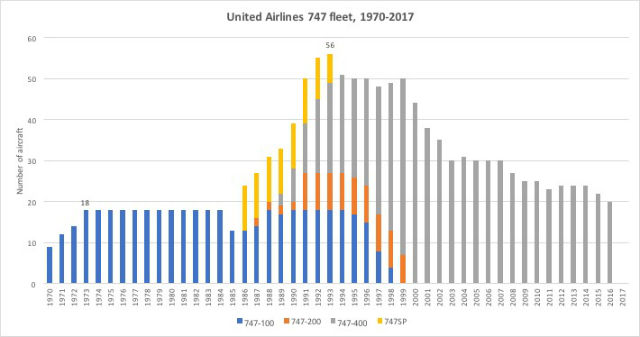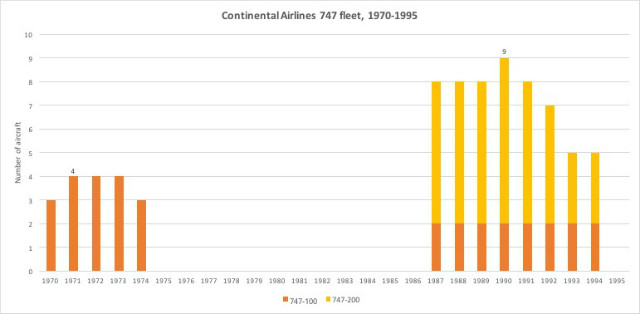United Airlines retires its last Boeing 747 today, ending a continuous nearly half-century run for the iconic aircraft in the carrier's fleet.
Flight UA747 departs San Francisco for Honolulu at 11:00 local time, recreating the Chicago-based carrier's inaugural 747 flight on 23 July 1970.
The 747-400 operating the last flight, registration N118UA and MSN 28811, was delivered new to United in February 1999, Flight Fleets Analyzer shows.
The -400 is the last jumbo variant in United's fleet, which has also included the 747-100, 747-200 and 747SP over the past 47 years. The fleet peaked at 56, consisting of 18 -100s, nine -200s, seven SPs and 22 -400s, in 1993, the database shows.

Fleets Analyzer
"It's a bittersweet milestone – this jumbo jet with its unmistakable silhouette once represented the state-of-the-art in air travel," said Scott Kirby, president of United, on the 747 retirement in a January letter to employees.
The airline has replaced its last 20 747-400s with 10 Boeing 777-300ERs that arrived this year. Another four 777s are due in 2018.
ROUGH START
"[The Boeing 747's] size and operational capabilities will provide travellers and shippers with the finest in air transportation," United wrote in its 1969 annual report that was published three months before the first jumbo jet arrived.
The airline's first 747-100 was the de facto flagship, or "Friend Ship" as it was referred to in marketing material, of its fleet at the time. Configured with 342 seats, including a new "Red Carpet Room" lounge on the upper deck, the first nine were rolled out on US transcontinental routes and from Chicago to the West Coast after the Hawaii launch in July 1970.
The introduction of the jumbo was not without its hitches. Flight instructors, rather than pilots, had to fly the inaugural flight to Hawaii as United and its union had yet to reach contract terms for the new 747, The Wall Street Journal reported at the time.
All the 747 glitter was not to be gold for United, at least not at first. The carrier lost $40.9 million in 1970, roughly $261 million in today's dollars, due among other things to industry overcapacity and the introduction of "very large wide-bodied aircraft", United president Edward Carlson wrote in its 1970 annual report published in March 1971.
Carlson, who replaced George Keck on account of the airline's poor financial performance, embarked on a series of cost savings initiatives that included deferring four 747 deliveries to 1973 from 1971.
When asked if he regretted the development of the 747, Carlson told The New York Times that April: "No, I think the timing is unfortunate because the plane which had to be ordered by the industry some time ago came on line when the economy was in a serious slump, but it is a good airplane and it's going to do a great deal for the industry."
United, unlike some US carriers, took delivery of all 18 of the 747-100s from its initial orders – five in 1966 and 13 more in 1967 – by 1973, the Boeing orders and deliveries database and Fleets Analyzer show. The fleet remained flat until 1985 when it fell to 13, but then jumped to 24 a year later when the airline acquired 11 747SPs as part of its purchase of Pan Am's Pacific assets in 1986.
The 747 would come to symbolise the carrier's Pacific network, with the 747-400 opening new routes such as Chicago-Hong Kong and replacing the smaller 747SP to Australia and other markets in the years after its introduction in 1989.
United would operate four 747 variants – the -100, -200, SP and -400 – for six years, from 1987 to 1994, Fleets Analyzer shows.
CONTINENTAL 747s
Continental Airlines, which merged with United in 2010, had its own brief 747 legacy. The airline was among the first to order the jumbo, committing to three in October 1966, a month before United, Boeing's database shows.
The then Los Angeles-based carrier debuted the jumbo jet on 26 June 1970 on flights between Chicago and Honolulu via Los Angeles.
However, Continental's first jumbo jet foray would last only until 1975 when it sold the last of its first four aircraft, Fleets Analyzer shows. One went to Wardair Canada while three were acquired by the government of Iran.

Fleets Analyzer
The 747 rejoined Continental's fleet when the airline acquired People Express in February 1987. The Newark-based discounter added two 747-100s and six 747-200s to Continental, by then based in Houston.
The airline supplemented the People Express aircraft with a former British Airways 747-200 in 1990, for a peak of nine aircraft that year, Fleets Analyzer shows.
The last Continental 747 was retired in 1995, Fleets Analyzer shows.
Source: Cirium Dashboard






















